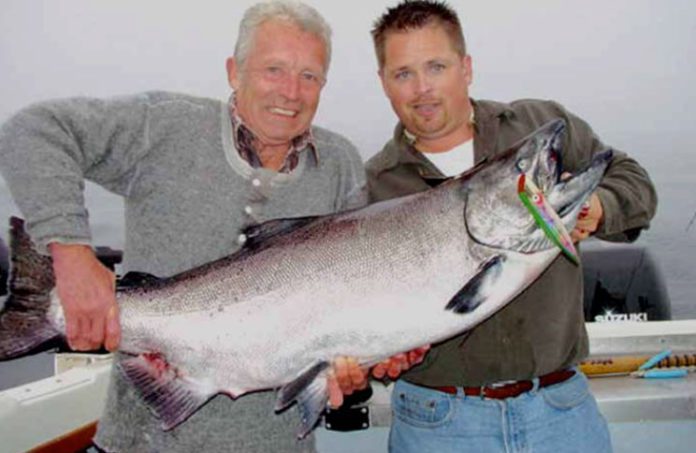With help from Tomic Plugs
That Campbell River is recognized worldwide as the “Salmon Capital of the World” is common knowledge. It’s neither an idle boast nor Chamber of Commerce hyperbole; it’s simply a fact. Just as it’s a fact that some other West Coast destinations enjoy periods of plenty while migratory runs pass through their respective areas, and a few have admittedly larger fish on average. Nevertheless, none can match the easily accessible, year-round salmon fishing available at Campbell River, nor come remotely close when considering the historical significance this vibrant, cosmopolitan city has played in the field of recreational fishing.
Tomic plugs are made with strong and light-weight plastic and are hollow—with exception of the Wee Tad. Hollow plugs cannot become waterlogged and all the lures are airbrushed by hand with lacquers that makes them very durable with extensive use.
The proper plug action is side to side. Not rolling over. You do not need a swivel, one could tie your main line to the plug. My preference is to use a leader of fluorocarbon about six feet long with a bead chain, then the main line.
When tying on your plug to the fluorocarbon line it’s very important to place the knot as far back and centre on the tow bar as possible. A trick is to have a second knot in place below the knot to the line you’re using (it’s just a knot that’s trimmed off).
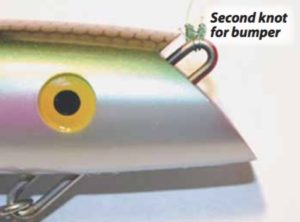
This knot below acts like a bumper to help keep the line as high up on the tow bar as possible. Just leave the bumper knot in place between uses. Having the knot high will give the plug the correct side to side swimming action.
If your plug has a ring and you like to tie to the tow bar, the ring can dangle below your line. Some fishermen say the dangling ring makes a little attractive noise. Or tie to the ring.
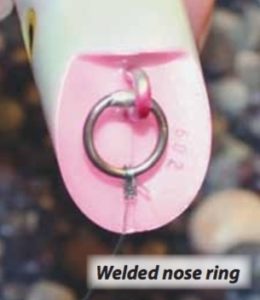
Some anglers like to add a second hook to the plug, double up a strong flexible line and knot it to the desired length.Loop line through the trailing hook and then through the pin. Ensure that the leading hook is on the split ring and placed ahead of the trailing hook line as this will help in any tangling problems. For a faster troll, lengthen the line so the hook hangs at the back of the tail; for a slower troll shorten the line, as the hook will fall away from the plug.
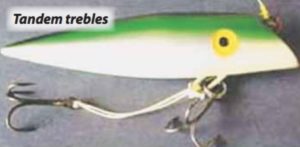
As noted, keeping the knot high is very important to the action of the plug; another method is the elastic band and or bead chain technique. Wrap an elastic band around the plug to the tail side of the tow bar, a bead chain on your leader before the lure. Put the bead chain under the elastic band. You can now vary how much pull the leader has by which beads the elastic band fits on; the farther back the leader is pulled, the more action the plug will have. Make sure the leader is centered. This technique is used for trolling at slower speeds (under two knots).

Tuning your plug in the water is so important. Don’t just throw your plug in the water and off you go. Look at your plug in the water by the side of the boat and make sure the action is an even side-to-side motion. If the plug keeps tracking to one side, push the knot in the direction you want the plug to track.
Some fishermen modify their plugs by removing the tow bar, then thread the leader through the resulting hole to the hook instead;the advantage is if the fish breaks you off, the plug will float up and you will get it back. Also, when the fish hooked the plug floats up the line so the fish is not tossing the plug around using it for leverage to help pull the hook. The action of the plug is now different; there’s more action and control with using the tow bar.
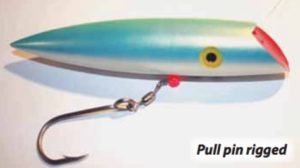
The speed is important to success because you don’t want the plug to roll; if it does, it’s going too fast. It’s generally believed that plugs are best trolled faster than you might when bait fishing; somewhere between 2.5 and 5.6 mph seems to work well. This is true of spoons as well.
Note the angle of your rigger line when you get a strike so you can repeat the same speed for future success.
With a fast lure, I believe the fish is more likely to act on instinct and strike (as salmon swim really fast), but if the lure is ambling by, the fish won’t have the urgency to catch it. If you are trolling fast and your plug is rolling over, you can change the hook to a bigger one, and that will act like a keel to allow the faster-trolling speed.
Plugs are not fished with flashers! One can use a dummy flasher off the cannon ball as this will give you the attraction power of the flasher.
What is important is the length of leader to allow for more plug action. Long leaders are like 25 to 60 feet from your downrigger clip. When I am fishing two rods I vary the distance behind the boat as well; and when I am checking the plug, I break my plug loose from the clip first and let it float to the top, as it will retain its action as it floats to the top, then I bring up my cannon ball. I have had more than one strike as the plug is floating on the surface.![]()


